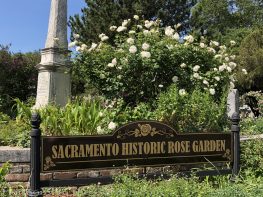 I can’t believe it, but I’m coming up on the 2nd year anniversary since moving up north to Granite Bay from the Bay Area. During the past two years, I’ve been having so much fun touring lots of public and private gardens in the area.
I can’t believe it, but I’m coming up on the 2nd year anniversary since moving up north to Granite Bay from the Bay Area. During the past two years, I’ve been having so much fun touring lots of public and private gardens in the area.
It seems like a lot of my favorite gardens are linked with historical sites, which is no surprise since I live in the middle of gold rush country.
The 30-acre Sacramento Historic Cemetery is one of the best.
I absolutely love this place, not only because of the impressive and enduring pioneering spirit of the people buried here, but because Sacramento’s garden community has helped to create a horticultural treasure.![]()
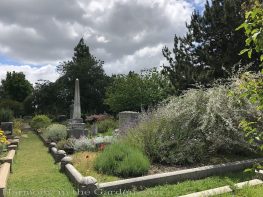
A few weeks ago I re-visited this cemetery, taking advantage of one of the last cool and cloudy days I’d see in awhile!
I decided to explore a bit and wander to the other side – it’s huge, don’t forget – 30 acres!
And while I’m pretty familiar with the well-known Historic Rose Garden, I was shocked to discover the most impressive California native garden I’ve ever seen, in addition to a pretty amazing mediterranean perennial garden.
Join me, and you’ll see why…
![]()
The California Native Garden
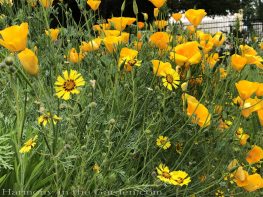 On the southwest side of the cemetery is the California Native Garden, maintained by the Sacramento Valley Chapter of California Native Plant Society.
On the southwest side of the cemetery is the California Native Garden, maintained by the Sacramento Valley Chapter of California Native Plant Society.
Covering nearly an acre are some of the most impressive examples of established native plants that I’ve seen yet. A lovely contrast to some native gardens that can look a little…oh, how shall I say it….parched, sparse, and a tad lackluster.
This is not the case in this garden – there are over 100 different species planted, several of which have been there 20+years! The only irrigation throughout the cemetery is sporadically placed hose-bibs to provide volunteers a way to give the plants occasional summer water. But for the most part, these plants rely on their ability to thrive in California’s hot and dry summer climate. ![]()
The cascading yellow spires of Golden Lupine ((Lupinus microcarpus ‘Ed Gedling‘) happily mixes with California poppies. Did you know that Golden Lupine is the official flower of the city of Davis?

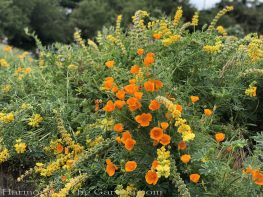
![]()
I have never seen a Flannel Bush this large! This variety is fremontodendron californicum ‘Pacific Sunset’, which is much larger than the ‘Ken Taylor’ variety that I normally plant in clients’ gardens. See how the ground beneath the tree is blanketed with a carpet of old, faded flowers? Looks really pretty, actually.
One note: if you’re thinking of planting this in your garden, please be aware that the foliage is covered with teeny tiny hairs that can be irritating to the skin when brushed against. Trust me, I speak from experience.
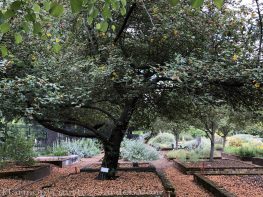
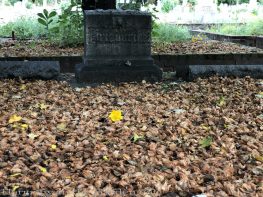
![]()
A stunning example of a 15-foot California Buckeye tree (aesculus californica). These are summer-dormant, so whenever a client asks for one in their garden, I make sure they realize it’ll look like it’s been blow-torched in the hot summer months unless it receives a fair amount of additional water. Not surprisingly, they usually pass. But in early summer, the white bottlebrush-like flowers are memorable.
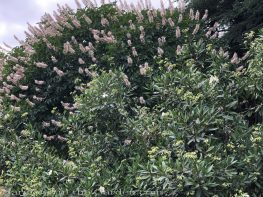

![]()
How cute are these sweet little wildflowers! The pink ones are often called ‘Mountain Garland’ (clarkia unguiculatas) and are happily mingling with our ubiquitous California poppies. The little yellow flowers are called Madia elegans and are sweetly scented and absolutely adorable.
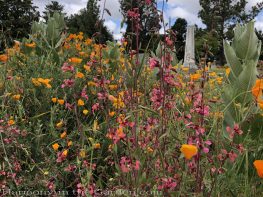

![]()
Here are two of my favorite natives happily cohabitating: Golden Sticky Monkeyflower (mimulus aurantiacus) and the Woolly Blue Curls (trichostema lanatum). Update: One of my wonderful readers left a great comment regarding the Woolly Blue Curls that I thought you’d all like to read. Thanks, Ronnie! One thing that I would like to share regarding Tricostemma (Woolly Blue Curls) is that I have also had challenges getting them to grow in my San Mateo garden so I was very excited to come upon a new hybrid at the Ruth Bancroft Gardens nursery called ‘Midnight Magic’, which is a hybrid between the native Mexican and U.S. Tricostemmas. It is reputedly more garden tolerant and easier to grow than the U.S. native and a little smaller. It’s color is lovely too!![]()
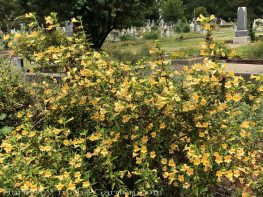

![]()
Sometimes my clients have a difficult time getting the Monkeyflowers to thrive in their gardens. I find this especially so when they’re watering these very drought tolerant subshrubs as they do the rest of their non-native plants. They really do want to live with very little water in very lean soil!
I’ll give you an example of some growing in my garden and neighborhood – on top of granite boulders with no soil! no water! no love! That’s how tough these plants are!![]()

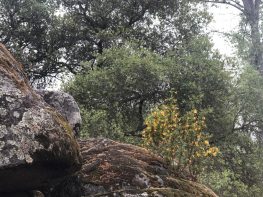
![]()
Another big, bodacious beauty is this Canary Island Sage (salvia canariensis var. candidissima). I recently purchased 2 of these from Annie’s Annuals for my new garden, knowing they’ll grow to 5’x5′ in a single season (according to the tag) but now I’m a little wary as seeing them in person, they were closer to 6′ tall (and the season is young!) ![]()
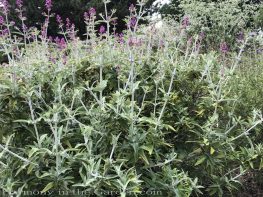
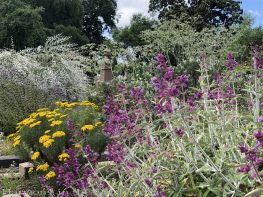
![]()
The Hamilton Square Garden
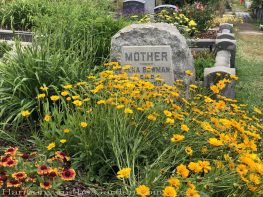 Toward the middle of the cemetery is the 1-acre Hamilton Square garden, consisting of mostly mediterranean perennial plants along with more California natives, and heirloom roses.
Toward the middle of the cemetery is the 1-acre Hamilton Square garden, consisting of mostly mediterranean perennial plants along with more California natives, and heirloom roses.
This garden is named after William Hamilton – the youngest son of Alexander Hamilton- who is buried here (yes, THAT Hamilton!) A piece of trivia for you: after William Hamilton was initially buried here he was subsequently exhumed two more times, then reburied. Yep – three times in three different locations.![]()
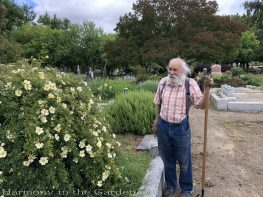 Sacramento’s Perennial Plant Club sponsors this garden, giving careful thought to the design of each plot, as well as recording the specific details of each plant. This is really, really useful for anyone interested in growing natives so they can see what works, what doesn’t, and what a specific plant might need.
Sacramento’s Perennial Plant Club sponsors this garden, giving careful thought to the design of each plot, as well as recording the specific details of each plant. This is really, really useful for anyone interested in growing natives so they can see what works, what doesn’t, and what a specific plant might need.
This is Jack, a wonderful volunteer I met. He talked with me for a long time, explaining how he loves weeding and working in this garden. He even took me over to his family’s plot, telling me all about his uncle and relatives buried there.
These are passionate people, to be sure.![]()
A few of the many plants that caught my eye were the sulfur-yellow Golden Coulter Bush (hymenolepis parviflora) and the towering 8-foot tall mound of beauty called Fremont’s Bush Mallow (malacothamnus fremontii). Both from Annie’s Annuals. I’m thinking Annie ought to have a plaque prominently placed somewhere…
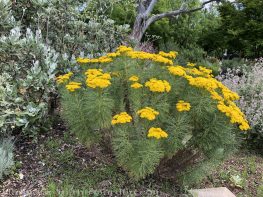

![]()
I’m not sure what this old rose variety is, but I thought the shape was magnificent. The Gopher Spurge (euphorbia wulfenii) happily re-seeded throughout a few cemetery plots.
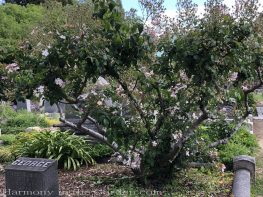
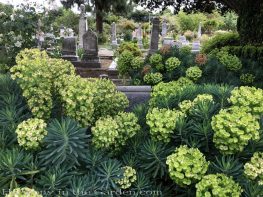
![]()
Native penstemon ‘Margarita Bop’ and the silver centaurea gymnocarpa ‘Velvet Centaurea’.
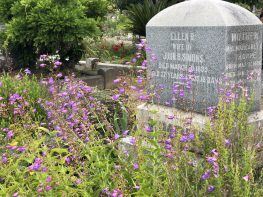
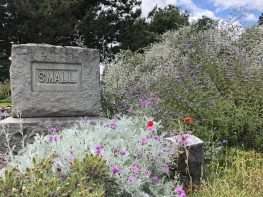
![]()
Sacramento’s Historic Rose Garden
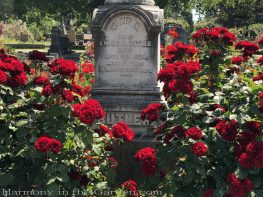 I can’t end this (very long) post without a brief mention of the 2-acre Sacramento Historic Rose Garden. It is, after all, the section of the cemetery that most local gardeners are familiar with.
I can’t end this (very long) post without a brief mention of the 2-acre Sacramento Historic Rose Garden. It is, after all, the section of the cemetery that most local gardeners are familiar with.
Throughout this garden are gold-rush era gravesites and plots that are overflowing with antique roses collected from cemeteries, old home sites, and along roadsides in Northern California. The roses here are ones that were popular during the times of the Gold Rush through the Victorian era (1850-1915).
I thought I’d share just a few images that were particularly outstanding when I visited. Sorry, but I don’t know the names of most of these, but you’ll get a good sense of how stunning this garden is in the spring. ![]()
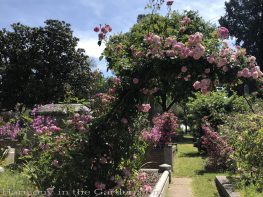
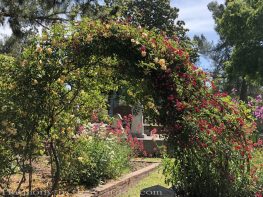
![]()
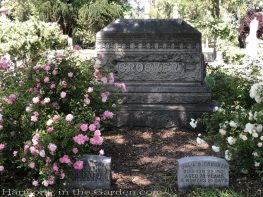
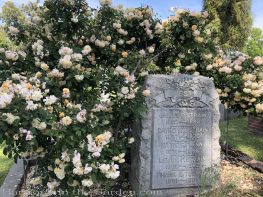
![]()
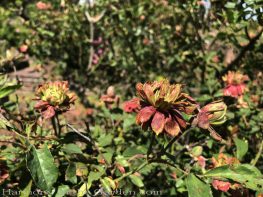
This is a rose that I’ve never seen before – the Green Rose (rosa chinensis ‘Viridiflora’).
Apparently, it starts out green then ages to a coppery color as in this photo. And, as if the color isn’t unique enough, all the flower parts are actually leafy structures.
If this is a rose you simply must add to your collection, you’re in luck – you can get one here.![]()
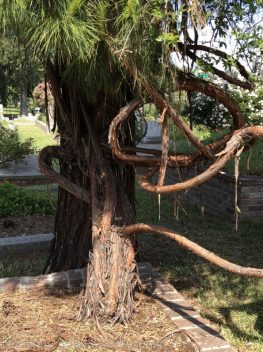

Is this incredible, or what! It’s a rosa banksiae normalis ‘Linda Street’ that has taken over this giant tree!
Zoom in, if you can, to see how it has scrambled to the very top!
Even the trunk of the rose has some hefty girth to it!
![]()
As if all this isn’t enough, in addition to hundreds of varieties of roses (close to 500!) are large sections of established colonies of iris.
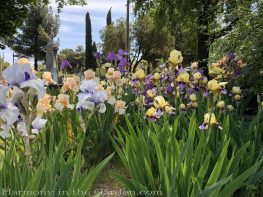
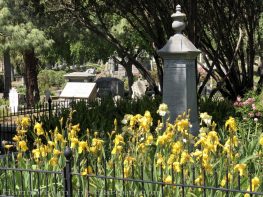
![]()
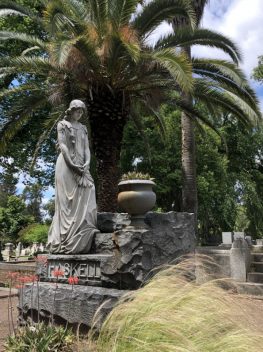
I hope you’ve all enjoyed the tour of this magnificent garden.
And I certainly hope that when the time comes, and we’re all long gone, someone out there creates a garden in our memory like these kind-hearted volunteers have done here. ![]()






16 Comments
This is lovely, as is your writing (as always). Thank you.
Thank you, Nicole, I’m glad you enjoyed the tour!
Rebecca,
Thanks for the reminder that California is naturally an arid place- even in NorCal. These natives are as tough as the pioneers buried under them.
Absolutely, Lin – what a great way to put it!
Oh what great information! Thank you for sharing it. I’ve never heard about the gardens at the cemetery and I’ll share this info with a friend who has family in Sacramento. They often go for walks and enjoy viewing gardens. I hope to go sometime too!
I learned about some new plants from your article as well! The silver-colored Centaurea gymnocarpa ‘Velvet Centaurea’ and the Golden Coulter Bush, Hymenolepsis parviflora are really stunning!
One thing that I would like to share regarding Tricostemma (Woolly Blue Curls) is that I have also had challenges getting them to grow in my San Mateo garden so I was very excited to come upon a new hybrid at the Ruth Bancroft Gardens nursery called ‘Midnight Magic’, which is a hybrid between the native Mexican and U.S. Tricostemmas. It is reputedly more garden tolerant and easier to grow than the U.S. native and a little smaller. It’s color is lovely too! Just planted one a few weeks ago so time will tell, but I am hopeful!
Hi Ronnie – thank you so much for that valuable info re: the Woolly Blue Curls! I’m going to insert your update into my post to let readers know. 🙂 Annie’s Annuals has a really great selection of natives so hopefully you can find the new ones you like there. Thanks again for taking the time to share your knowledge with us!
I must visit this garden some spring, hopefully, in the next year or two. Thanks for sharing!
You’re so welcome, Tami. It’s quite an amazing garden so I hope you get to see it in person!
I’m so inspired. I can smell those roses. Thank you Rebecca.
I wish you lived closer and we could visit the garden in person, Gigi. 🙂
That’s a pretty amazing place with so many beautiful plants. Thanks for taking us along.
You’re very welcome, Barbara!
What a beautiful garden! Thank you for sharing it! Nice place to rest in peace!
Thanks, Donna. It’s really quite stunning and I agree – it would be a lovely place to rest in peace!
thanks Rebecca for the educational tour!
You’re welcome, Terri!